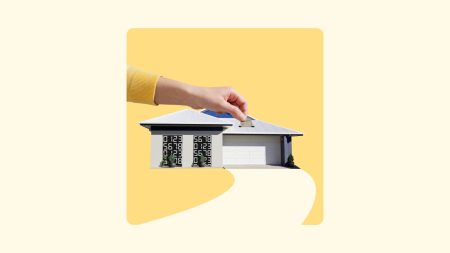Key takeaways
- Non-QM loans are an option for those who might struggle to qualify for a standard mortgage, such as self-employed borrowers and gig workers.
- Non-QM loans have more flexible income and credit standards, but they require higher down payments and charge higher interest rates.
- Non-QM loans also lack consumer protections required by the CFPB, so borrowers should be especially careful to understand the terms and conditions.
If you’re having difficulty qualifying for a mortgage — especially due to your credit, income level or income predictability — a non-qualified mortgage, or non-QM for short, can fill the gap. While non-QM loans offer more lenient credit and income requirements, they also come with higher down payments and interest rates — and they lack important consumer protections.
What is a non-qualified mortgage?
A non-qualified mortgage is a type of mortgage that doesn’t conform to certain standards set by the Consumer Financial Protection Bureau (CFPB). These standards prohibit specific loan features, like balloon payments, and mandate criteria lenders must use to evaluate applicants’ finances and ability to repay. Asset-based loans and no-income loans are common examples of non-QM loans.
Non-QM lenders also tend to use manual underwriting and have more flexibility in underwriting guidelines. They’ll work with borrowers whom conventional lenders might deem too risky because of their non-salaried income or low credit scores. These loans have:
- Different income verification options: For example, instead of W-2 forms and paystubs, borrowers may be able to document their financial situation with bank or investment account statements, 1099s, receipts from rents or leases or other business receivables, among others.
- Looser debt-to-income rules: The CFPB requires QM borrowers’ debt-to-income (DTI) ratios to be no more than 43%. Borrowers of non-QM loans may carry higher levels of debt, often up to 50% of their total monthly income.
- More lenient credit restrictions: In some cases, non-QM loans don’t require a waiting period after bankruptcy or foreclosure, enabling individuals to secure a mortgage soon after these events.
How does a non-qualified mortgage differ from a qualified mortgage?
With that flexibility comes risk — for the lender, but also for the borrower. Non-QM loans may have risky features prohibited by the CFPB, including:
- Loan terms longer than 30 years
- Interest-only payments without paying down the principal
- Balloon payment (a big lump-sum payment at the end of a loan term)
- Negative amortization, which allows your loan balance to increase over time
Additionally, QM loans are subject to the CFPB’s cap on upfront mortgage points and fees. For loans of more than $100,000, these charges can’t total more than 3% of the loan amount. Lenders may charge more in points and fees for non-QM loans.
A lender may also issue a non-QM loan without following the CFPB’s “ability- to-repay” rule, that is, examining these eight components of a borrower’s finances:
- Current income/assets
- Current employment status
- Monthly payment for this mortgage loan
- Monthly payment on any simultaneous loan that’s secured by the home such as a piggyback mortgage (usually taken out when a borrower doesn’t have enough cash for a down payment)
- Monthly payment for mortgage-related obligations
- Current debt obligations, alimony and child support
- Monthly debt-to-income ratio or residual income
- Credit history
Less stringent standards on non-QM loans may make it more likely for non-QM borrowers to receive a loan that they can’t truly afford.
| Underwriting guidelines | Qualified mortgage | Non-qualified mortgage |
|---|---|---|
| Debt-to-income (DTI) ratio | Typically limited to 43% | Typically limited to 50% |
| Income documentation | W2s, paystubs | Bank statements, investment account statements, 1099s, other |
| Waiting period after bankruptcy or foreclosure | Two to seven years | None, in some cases |
| Assets can count as income (“asset depletion”) | Not allowed | May be allowed |
The Consumer Financial Protection Bureau established its Qualified Mortgage standards in 2014. They were largely in response to certain irresponsible lending practices of the early 2000s: lack of due diligence into applicant finances, people receiving loans they really couldn’t afford and terms that made delinquency or default more likely. All of this contributed to the 2007 subprime mortgage crisis, with its wave of defaults and foreclosures.
Who can benefit from non-qualified mortgages?
While CFPB’s Qualifying Loan standards are intended to safeguard consumers, they can sometimes be exclusionary to those whose financial profiles don’t fit the norm.
Here’s who may benefit most from a non-QM loan:
- Self-employed borrowers: These borrowers generally have sporadic pay and multiple income streams, making it hard to get a qualified mortgage. Many self-employed, non-QM borrowers get bank statement loans, which are based on their cash flow and liquid assets (rather than relying on W-2s).
- Real estate investors: These are the folks who fix-and-flip homes, or who rent out and generate an income from the homes they buy, and need funding quickly. DSCR loans (short for debt service coverage ratio) and asset depletion home loans (in which you tap the equity in your primary residence to fund the purchase of another property) often accommodate this sort of borrower.
- Foreign nationals: Non-resident borrowers who want to purchase property in the U.S. might not qualify for a traditional loan because of a low or non-existent U.S. credit score. Non-QM lenders use international credit reports and letters from creditors to qualify this group for a foreign national home loan. Mitigating factors, such as a high income, robust liquid assets and a large down payment, also help foreign borrowers qualify for non-QM loans.
- Prime borrowers: Borrowers who have pristine credit but are in search of a loan with certain features, such as interest-only payments or a debt-to-income ratio limit above the standard 43 percent, are considered “prime non-QM borrowers.”
- Near or non-prime borrowers: In many cases, these are borrowers who have insufficient credit, a prior bankruptcy or distressed property sale within the last two years. Lenders tend to require more money down and may have tighter standards elsewhere to lessen the credit risk.
- Borrowers with significant assets: A type of non-QM loan, called an asset qualifier loan, is ideal for borrowers with prime credit and substantial assets. Although the borrower could buy the home outright, they may decide to finance the purchase to keep money invested elsewhere. Credit invisibles — people who have considerable assets but prefer not to use credit cards — are good candidates, too.
What are the drawbacks of a non-QM loan?
Non-QM loans can be a viable alternative to conventional financing — but these benefits come at a cost. Non-QM loans typically have higher fees, down payment requirements and interest rates. Non-QM 30-year fixed-rate loan rates are typically a percent or two higher than the prime 30-year fixed mortgage rate, according to Fitch Ratings. QM loans for highly qualified buyers can have rates closer to the prime rate.
The stiffer terms exist to compensate the lender for the additional risk they’re taking on — since Fannie Mae and Freddie Mac cannot purchase non-QM loans.
Finally, the loan could be riskier for the borrower. There’s a reason the CFPB frowns on features like balloon payments and interest-only repayments — they increase the likelihood of delinquency and default. At the very least, the non-QM loan is likely to be more expensive than a traditional mortgage of comparable size and term.
Is a non-qualified loan the same as a non-conforming loan?
Non-qualified loans are different from non-conforming loans. Both types of loans are outside the norm for mortgages, but they are outside two different norms: A non-QM loan deviates from standards set by the CFPB, and non-conforming loans don’t meet standards set by the Federal Housing Finance Agency (FHFA), often because they exceed a certain amount — $806,500 in most parts of the U.S. in 2025.
However, non-conforming loans are considered a category of non-QM loans. And there is overlap in the FHFA’s and the CFPB’s standards. For example, like QM loans, conforming loans often require applicants to have a DTI of no more than 43 percent.
Where can you get a non-QM loan?
If you’re interested in a non-QM loan, there are several places you can turn. Start by determining your eligibility: Typically, you’ll need a minimum credit score of 620, stable income and a consistent employment history.
Once you’ve confirmed your eligibility, you can then search for a lender that offers non-QM loans. Many mortgage brokers work with non-QM wholesale lenders, so they might be a good resource.
When you find a lender, ask if they’ll first run you through an automatic underwriting, just to make sure you couldn’t get a qualifying loan after all. Also ask lenders whether they originate their own non-QM loans, or if the loan is backed by another company that will service your loan. Take the time to understand what fees you’ll pay, as well as any special loan terms or features that might add to your overall borrowing costs.
You should always fully understand the terms of your mortgage. But it’s especially important to read the fine print and be aware of the worst-case scenario of any non-qualifying loan you consider.
FAQs
Read the full article here









